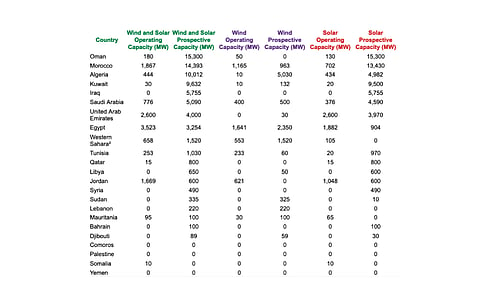

Arab speaking Middle East and North Africa (MENA) nations currently have as much as 60.9 GW of new utility scale solar and wind power plants that are planned to come online by 2030, and Global Energy Monitor (GEM) believes they are on pace to increase it from more than 12.1 GW operational capacity at present.
US based non-governmental organization, GEM counts this capacity comprising more than 49.5 GW prospective utility scale solar and over 11.3 GW wind energy projects, planned to become operational by 2030. There is another 12.5 GW solar power project for green hydrogen in Oman that's scheduled to come online by 2038. So, altogether 73.4 GW in the pipeline.
Currently, utility scale solar projects add up to 7.5 GW operational renewable energy capacity in the region, along with 4.7 GW of wind farms, states GEM in its report A Race to the Top.
While currently Egypt with its 3.5 GW and the United Arab Emirates (UAE) with 2.6 GW of total operational solar and wind capacity lead the region, Oman, Morocco and Algeria are coming up fast as strong markets with their collective pipeline of more than 39.7 GW—'nearly four times their prospective new gas-fired capacity'.
To be more specific, Oman plans to bring in 15.3 GW utility scale solar and wind by 2030, Morocco 14.4 GW, Algeria 10.0 GW, Kuwait 9.6 GW and Iraq 5.8 GW.
GEM believes this will help the Arab League meet the collective goal of developing 80 GW of renewable energy by 2030.
"The Middle East and North Africa have always had tremendous potential for wind and solar development, but to see these countries shunning fossil gas in favor of renewables and at this scale is stunning," said Project Manager for the Global Solar Power Tracker Kasandra O'Malia.
Solar projects planned in the region have an average size more than 4 times larger than rest of the world.
Interest in renewables for MENA nations is driven by the need to capitalize on the demand for energy storage as well as the desire to become a 'transcontinental' for renewable energy exports along with renewable hydrogen and ammonia, mainly to Europe that's looking for ways to shed gas imports.
The complete English version of the report can be downloaded for free from GEM's website.
